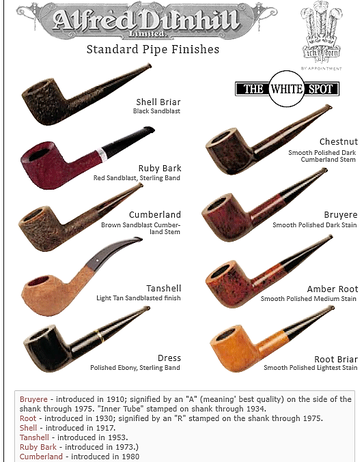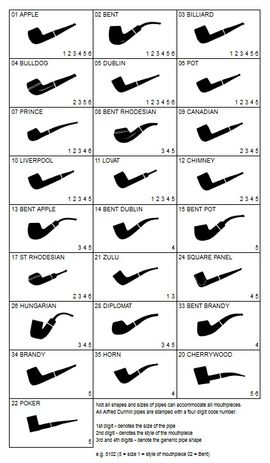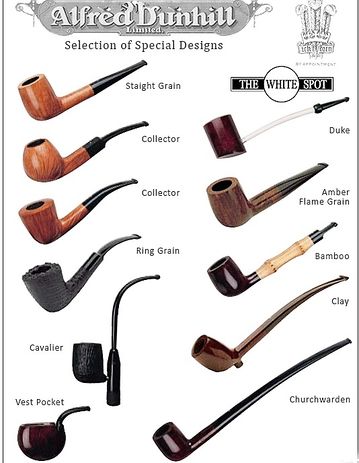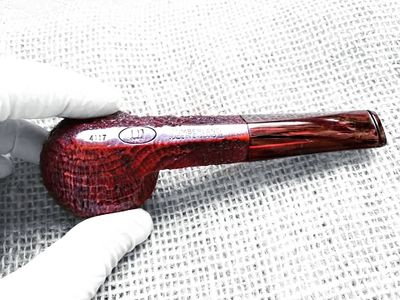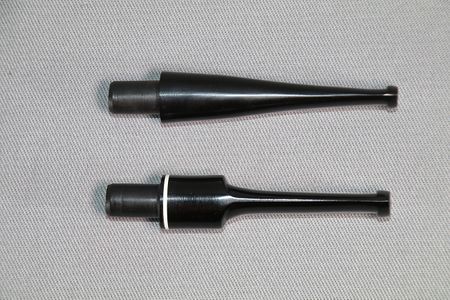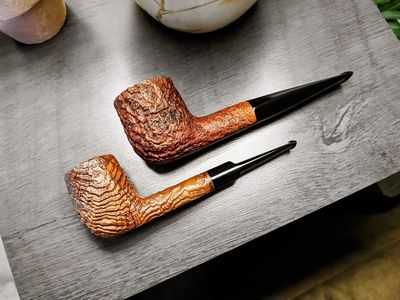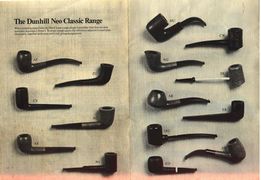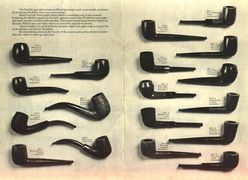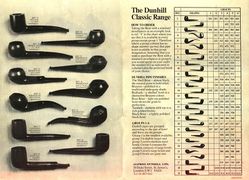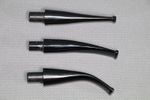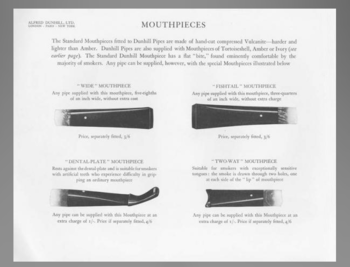Dunhill Shape Chart
Currently 35 shapes classified with 2-digit numbers.
Occasionally a piece of briar is just asking to be carved into a shape which is not in the standard list. The general term for such pipe shapes is “Quaint”. The current system with 4 digits visible has now been in place for over 30 years, and has proven to work very well for Dunhill, the trade, and for consumers.
| Example: 4117 | (4: Group; 1:tapered stem; 17: Shape: Straight Rhodesian* - Dunhill criteria. |
Although the scarcity of fine briar has always necessitated the pricing of Dunhill according to the amount of root employed in their manufacture, it is important to remember that, irrespective of size and price, they are of one quality only – the finest. The bowls are sorted into 6 groups.
| Group 1 / Small | Group 2 / Small to Medium | Group 3 / Medium | Group 4 / Medium to Large |
| Group 5 / Large | Group 6 / Large to Extra | XL / Extra large | XXL or Giant |
"The sizing for a given group size will also depend on the shape of a pipe, i.e. the dimensions for a Billiard in group 4 will obviously be different to the dimensions of a Pot or Chimney in the same group size. Also, even within the group size of a particular shape (say a Billiard in group 4) there will always be variations for a multitude of reasons. To name a few:
- the pipes are largely hand-made, so naturally, there will always be slight differences in size;
- we might use different variations of a particular shape (that are all categorised as a Billiard Group 4), i.e. a standard Billiard shape or a more “Barrel” type Billiard shape or a Billiard with a bevel rim or a Billiard with an oval stem… all of which would cause those pipes to differ from each other in terms of their dimensions;
- we work and re-work our pipes tirelessly to eliminate any flaws as much as possible, which will also have certain effects to the dimensions of a pipe;
- sandblasted pipes will be slightly smaller compared to the same pipe in a smooth finish due to the sandblasting process, which - albeit slightly - still reduces the outer dimensions (and the weight) of a pipe.
Above list is not exhaustive, but gives a good idea, why there are no exact measurements for the dimensions of our pipes." Hener, K. S., Product Line Director - The White Spot Smoker's Accessory Division and Walthamstow site (January, 2020).
The encircled group number indicates the size of the bowl (1, for example, is the smaller bowl). It is usually followed by a letter corresponding to the pipe finish. This number/letter code has been introduced about 1950 and was discontinued about 1976 replaced by a 4 or 5 digits code. They were reintroduced in March 2012, but only for commemorative versions.

|

|

|

|

|

|
The original skus/model numbers from the 1920’s until the early 1970’s stood for very specific shapes and bowls. For example, the codes 31, 34, 59, 111, 113, 117, 196, LB, LBS... were all different types of Billiard shaped pipes and there were about 50(!), such codes for the Billiard shape alone.
| CH - Skater | CK - Bent Rhodesian | SS - “Quaint Shape” Billiard hexagonal shank & tapered bit 1928 |
| EC - “Quaint Shape” Canadian, oval shank, short tapered bit 1928 | FR - “Quaint Shape” Octagonal panel billiard, round shank, extended tapered bit 1928 | OE - “Quaint Shape” Octagonal panel billiard, square shank, angled tapered bit 1928 |
| O - Squat Bulldog | OR - Straight Rhodesian | OX - Saddle Bulldog |
| OXS - Bulldog | P - 1/2 Bent Bulldog | PO - 1/4 Bent Bulldog |
| EK - “Quaint Shape” Hexagonal panel billiard, square shank, angled tapered bit “Stand-up” 1928 | VT - “Quaint Shape” tirangular panel billiard, tirangular shank and bit “Stand-up” 1928 | SA - “Quaint Shape” octogonal tall panel billiard, hexagonal shank, angled bit “Stand-up” 1928 |
| GD - “Quaint Shape” Circular tall billiard, ringed low at bowl base, round shank and bit 1928 | PK - “Quaint Shape” Four sided panel billiard, diamond shank and bit 1928 | PL - “Quaint Shape” Four sided panel billiard,triangular shank and bit 1928 |
| EL - “Quaint Shape” Four sided panel billiard, triangular shank and bit 1928 | ES - Canadian | HB - Bent |
| HU - Hungarian | FJ - “Quaint Shape” Cutty, canted round bowl, extended tapered bit 1928 | KS - “Quaint Shape” Apple, flattened bowl support peg “Stand-up” 1928 |
| K - “Quaint Shape” Round Apple, converging rim, round shank, tapered bit 1928 | KB - Urn (Quaint shape) | FE - “Quaint Shape” Apple, large squat bowl, round shank, extended tapered bit 1928 |
| FET - “Quaint Shape” Apple, large squat bowl, round shank, extended tapered bit 1928 | E - “Quaint Shape” Army mount (silver) large squat bowl, round shank, extended tapered bit 1928 | ET - “Quaint Shape” Army mount (silver) large squat bowl, round shank, extended tapered bit 1928 |
| EK - Paneled billiard 1950, 1969 | LV - Straight Brandy | LB - Long Billiard |
| LBS - Billiard (Longer) | LC - Large Curve | LF - Dublin |
| LOX - Bulldog | U - Shield Bulldog | US - Beehive - Quaint shape |
| UT - Quaint shape | R - Pot | SU - Barrel |
| TLY - Bent Billiard (large) - Saddle Stem. | VS - Brandy | W - Bamboo |
- Eric Boehm offers to us a list of the principals shapes: 2-digits and ODA list by Loring: Dunhill Shapes List
A 3-digit system (“Interim”) was developed that showed a logical approach to identify pipes in terms of size, mouthpiece, and shape, with the 1st digit being the size, the 2nd digit the mouthpiece, and the 3rd digit the shape, i.e. the old “85” became a “321” which was a group 3 Apple with taper mouthpiece. This was soon to be replaced by a more detailed, formal 4- and 5-digit system around 1978.
The first image on the right, (with the shape number 577) falls into this system, so 577 has no special meaning apart from describing/being the model for that particular pipe shape (in this case a specific group 2 Billiard with saddle mouthpiece). Around 1973, with the introduction of computers, new categories were introduced that indicated size, mouthpiece, and shape. As for the “T”, in 1952 a full-size “T” was added after the circled group size stamp to further describe the Tanshell finish (in 1953 the “T” was reduced to about half the size). So this pipe dates from 1952.
The 5th digit indicated the style of the bowl within the group of a similar classification, each identified by the last digit, which could be any number between 1-9.
While e.g. within the Gp.4 Billiard there were 5 different styles of bowls (5th digit being either 1,2,3,4, or 9), for a Gp.1 Billiard there were only 3 styles used (5th digit being 1, 2, or 9).
Although the 5-digit code was stamped on the pipe and thus was visible to the consumer, it was mostly used for internal production planning purposes and to a lesser extent for retail staff. The system proved to be quite complex.
The elimination of the 5th digit on the pipes (in 1984) resulted in better management of the pipe stock as there were less skus and it also facilitated the work for the sales staff in the retail shops as the complexity and number of skus was considerably reduced.
- |*Numbers 7 & 8 are not used nowadays as The White Spot now make all mouthpieces as fishtail as standard practise.
- | When 5 digits occur, the meaning of the 4 first remain the same.
- | 5 digit shape numbers was added in 1976 and ended in 1984.
- | Some sources such as the Pipephil portal, indicate this change in markings occurred in mid-1976, others indicate it was 1974.
- | Before 2007 there were only two classifications for mouthpieces (1= tapered, 2= saddle). After this period, 9 patterns are used (4303, 3903, 5403,...). Today only 7.
- | Usually pipes with fishtail bit receive a stamp (FT) next to the shape number.
- | In the encircled group number, letter corresponding to the pipe finish: “S” for Shell; “A” for Bruyere; “T” for Tanshell and “R/B” for Red Bark. *9mm its about filter.
- | 120, 196, P, R are old shape names from the '20s and '30s, which the Dunhill reintroduced for the White Spot Collection only.
- | "F/T" (fishtail) mouthpiece was designed only in the 1930's.
Special thanks to Mr. Hener (The White Spot Division) for his valuable contributions.
Yang (talk) 11:11, 7 January 2020 (CST)
